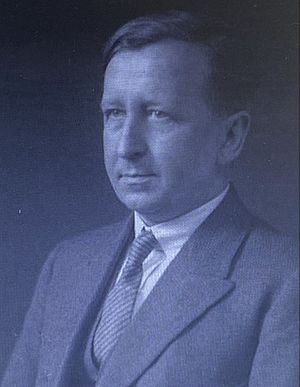George Ridsdale Goldsbrough facts for kids
George Ridsdale Goldsbrough was an important English mathematician and scientist. He was born on May 19, 1881, in Sunderland and passed away on May 26, 1963, in Stratford-upon-Avon. He spent his life studying complex topics like ocean tides, currents, and how satellites move in space. His work helped us better understand our planet and the universe around us.
Contents
Early Life and Learning
George Goldsbrough went to Bede Higher Grade School. After that, he started studying at Armstrong College. He finished his studies there in 1903 with excellent grades. From 1905 to 1919, he worked as a senior math teacher at Jarrow-on-Tyne Secondary School.
Around 1910, another scientist named R. A. Sampson suggested that George should research how tides work. This idea led George to focus on the science of tides and how gravity affects things in space.
During the First World War, George Goldsbrough helped out at a factory called HM Factory, Gretna, located in Dornock. His name is even recorded at the Devils Porridge Museum in Eastriggs.
His University Work
In 1919, George Goldsbrough returned to Armstrong College. He became a lecturer in applied mathematics. Later, in 1922, he became a "Reader" in dynamical astronomy. This meant he was a leading expert in how things move in space. By 1928, he was made the Second Professor of Mathematics.
In 1937, Armstrong College became part of King's College, Durham. George continued his work there. In 1942, he took over as the head of the Department of Mathematics, following T. H. Havelock. He stayed in this important role until he retired in 1948.
Studying the Oceans
George Goldsbrough made big steps in understanding ocean tides and currents.
Understanding Tides
Before George, in the late 1890s, a scientist named Sydney Samuel Hough used math to study tides in a huge, deep ocean without any land. In 1915, George Goldsbrough made Hough's work even better. He published new ideas about how tides behave in different parts of the ocean, including areas near land.
Later, in 1950, he shared a new way to solve the math problems for tides on a spinning Earth. His method helped scientists understand tides even when oceans had boundaries along certain lines.
Ocean Currents
In the 1930s, George Goldsbrough published two important papers about steady ocean currents. He included how the Coriolis effect changes depending on how far north or south you are. The Coriolis effect is a force that makes moving objects (like ocean currents) curve because the Earth is spinning.
His work was very advanced for its time. It helped set the stage for later theories by other famous scientists. For example, his ideas were similar to Rossby's theory about "planetary waves" in 1939. They also related to Sverdrup's 1947 theory about how wind affects ocean currents. And they even connected to Stommel's 1948 theory explaining why ocean currents on the western side of oceans are often stronger.
Satellites in Space
Beyond oceans, George Goldsbrough also studied how satellites move. In 1941, he published a detailed study on how one satellite can affect the movement of a whole ring of satellites. Then, in 1951, he looked at how stable two rings of particles are when they orbit a main object.
Recognitions and Legacy
George Goldsbrough passed away on May 26, 1963. He was 82 years old and was sitting in a deckchair in the gardens next to the Royal Shakespeare Theatre in Stratford-upon-Avon.
Awards and Honours
- 1929 – F.R.S. (This means he was made a Fellow of the Royal Society, a very high honor for scientists.)
- 1948 – C.B.E. (This stands for Commander of the Order of the British Empire, another important award.)


